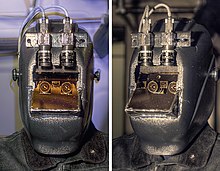計算機媒介現實
此條目的引用需要清理,使其符合格式。 (2018年5月16日) |



計算機媒介現實是通過可穿戴計算機或者便攜儀器[1],如智能手機,從用戶的視角加,減或操縱信息。一般來說,如EyeTap等的電子儀器或智能手機可以被用來實現對用戶視覺環境的媒介。它可以像視覺過濾器一樣在真實世界與用戶視角之間工作。計算機媒介現實已經被用來幫助視覺障礙病人增強視覺能力[2]。這個例子使本可以直達用戶眼睛的視頻輸入光線,通過計算機過濾成一個更有用的形式,從而實現了被媒介現實。它還被應用於相互交流的計算機接口[3]。用計算機媒介現實來移除或掩蓋視覺數據,從而減少感官知覺,已經被用來應用在建築,還有一些正在研究的領域[4]。對於其改變可觀察現實的長期影響還沒有被完全研究透徹,引發長期的副作用也不是沒有可能的。
作為視覺輔助
[編輯]在1970年和1980年之間,史蒂夫曼恩介紹了第一代與第二代的「數字眼鏡」。從一開始,它就被當作幫助人們提升視力的視覺輔助,電焊頭盔,[5][6][7][8]以及普通日常視覺輔助,就像在IEEE 科技與社會31(3)[9]以及標題為「玻璃眼睛」 的補充材料中提到的那樣。[10] 在這一點上,媒介現實是一個合適的包含混合現實,延伸現實以及虛擬現實的超大集成體,同時它也包括被減弱現實。[11]
窗口管理者
[編輯]一個常用的媒介現實的窗口管理者是「現實窗口管理者」[12]
無線媒介現實
[編輯]藍牙設備是常用於做媒介現實的[13]。用無線的通信,媒介現實也可以在不同的社區中成為一個通信中介[14]。 這樣的互動叫做「seeing eye-to-eye(從眼睛裡看見)」[15]。
應用
[編輯]媒介現實的應用包括幫助人們提高視力的設備,遊戲設備,器械維修設備,遠程醫療,遠程專家諮詢,以及尋路設備等等。媒介現實也被運用在機器人[16],畫圖領域,比如「Loose and Sketchy」畫圖包[17].
相關理論
[編輯]媒介現實有關的理論包括增強現實(一種特殊的媒介現實),虛擬現實,混合現實等等[18]。
引用
[編輯]1. ^"Wearable,Tetherless, Computer-Mediated Reality", Technical Report #260, M.I.T. Medial Lab Perceptual Computing Section, Cambridge, Massachusetts, 1994
2. ^ Video mediation
3. ^ Grasset, R.; Gascuel, J. -D.; Schmalstieg (2003). "Interactive Mediated Reality". The Second IEEE and ACM International Symposium on Mixed and Augmented Reality, 2003. Proceedings. pp. 302–303. CiteSeerX 10.1.1.109.7275 . doi:10.1109/ISMAR.2003.1240731. ISBN 0-7695-2006-5.
4. ^ See, for instance, here and here Archived 2005-11-30 at the Wayback Machine.
5. ^ Quantigraphic camera promises HDR eyesight from Father of AR, by Chris Davies, SlashGear, Sep 12th 2012
6. ^ IEEE Spectrum
7. ^ IEEE Computer
8. ^ A magical welding helmet that lets you see the world in HDR–in real-time
9. ^ Through the Glass, Lightly, IEEE Technology & Society, Volume 31, Number 3, Fall 2012, pages 10-14
10. ^ "GlassEyes": The Theory of EyeTap Digital Eye Glass, supplemental material for "Through the Glass, Lightly", IEEE Technology and Society, Vol. 31, No. 3, Fall 2012
11. ^ Mann, S., & Fung, J. (2001). Videoorbits on EyeTap devices for deliberately diminished reality or altering the visual perception of rigid planar patches of a real world scene. Proceedings of the Second IEEE International Symposium on Mixed Reality, pp 48-55, March 14–15, 2001.
12. ^ Mediated Reality, by Steve Mann, Linux Journal, Article No5, Issue59, 1999march01, ISSN 1075-3583
13. ^ Mediated Reality Bluetooth Device Locator Archived 2011-07-06 at the Wayback Machine. by S Parikh et al., IEEE CSIDC 2002
14. ^ Guo, Z.; Zhu, J. J. H.; Chen, H. (2001). "Mediated Reality Bites: Comparing Direct and Indirect Experience as Sources of Perceptions Across Two Communities in China". Int. J. Public Opin. Res. 13 (4): 398–418. doi:10.1093/ijpor/13.4.398.
15. ^ Tang, F.; Aimone, C.; Fung, J.; Marjan, A.; Mann, S. (2002). "Seeing Eye to Eye: a shared mediated reality using EyeTap devices and the VideoOrbits Gyroscopic Head Tracker". Proceedings. International Symposium on Mixed and Augmented Reality (PDF). pp. 267–268. CiteSeerX 10.1.1.134.7981 . doi:10.1109/ISMAR.2002.1115106. ISBN 0-7695-1781-1.
16. ^ Daniel Suarez: Daemon: Bot-mediated Reality (discussion of Mediated and Augmented Reality, bots, etc.)
17. ^ Haller, M.; Landerl, F.; Billinghurst, M. (2005). "A Loose and Sketchy Approach in a Mediated Reality Environment". Proceedings of the 3rd international conference on Computer graphics and interactive techniques in Australasia and South East Asia. pp. 371–379. CiteSeerX 10.1.1.61.6181 . doi:10.1145/1101389.1101463. ISBN 1-59593-201-1.
18. ^ Mediated Reality with implementations for everyday life, Presence Connect, MIT Press journal PRESENCE: Teleoperators and Virtual Environments, Date Posted: 2002 August 6
